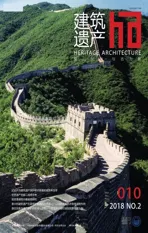城墙:基础建筑中的权与力
2018-02-14TheWallStrengthandPowerinFundamentalArchitecture
The Wall: Strength and Power in Fundamental Architecture
[美 ]詹姆斯 · 沃菲尔德 James Warfield
顾心怡 译 Translated by Gu Xinyi
没有什么比墙的筑造更能引领建筑的发展了。在中国,长城在山河间绵延千里,展现着帝王的权力与建筑者的规划和筑造技艺。在秘鲁,萨克塞瓦曼堡巨大的“之”字形城墙将帝王的权力与石匠的技艺结合,创造出一种放眼世界前无古人,后无来者的石墙精确砌筑的技艺。这两处伟大的纪念性建筑代表了人类在建造最基本的建筑部分——墙体上最为原始的努力所达到的建筑技艺的高度。
总而言之,那只不过是墙上的又一块砖而已。
——平克·弗洛伊德《迷墙》
比起建造行为的其它方面,承重墙的建造最为基本,也最具有逻辑性。美国诗人罗伯特 · 弗罗斯特在其诗作《修墙》中生动描绘了砌筑最简单的石墙所具备的清晰的建造方法。
我们走的时候,中间隔着一垛墙。落在各边的石头,由各自去料理。有些是长块的,有些几乎圆得像球。需要一点魔术才能把它们放稳当。①《修墙》的中文表达使用梁实秋译文。——译者注
一块块石头、一步步慢慢垒起墙面,这一简朴的建造努力代表了自原始时代开始的服务于人类需求的筑造方法。对建造者而言,几乎立刻就能感到一种实在的成就感,得到一座可见的建成品,同时也是辛勤劳动的回报。多数文化中最早出现的遮蔽物是基本的,由地方材料手工建成,或者用石块垒叠起来。随着时间的推移,有些文化发展出一些石造技术,墙也成为了用于处理防卫、隐私、土地所有权,甚至城镇规划等更加复杂的社会和文化问题的设计工具。最早的墙体可能出现在乡村地区,通过清理地上的石头,建起石围墙来划定种植地块。此后,用当地石材建造承重墙的技术作为一种房屋的基本建造方法发展起来,农场也增加了围墙,以圈养牲畜并宣示土地所有权。最终,石造墙体围合出了农场主家的房子,乡镇社区也随之逐渐形成。城镇中的墙体限定出街道,并且在将公共活动分流的同时为墙背后的居民提供私密性。
我在造墙之前,先要弄个清楚,圈进来的是什么,圈出去的是什么,并且我可能开罪的是些什么人家,有一点什么,它不喜欢墙,它要推倒它。
——罗伯特·弗罗斯特《修墙》
随着文明的进步,防卫需求也逐渐增加。加固的城墙成为普遍需要,这一最基本的建筑元素也具有了文化意义。在弗罗斯特优美的诗作中提到了建造任何墙体内在的社会学意义。从前罗马时期到文艺复兴,带有城墙的防卫性城市与纪念性的城塞成为人类保护其社区免受怀有敌意的外来者的破坏与侵犯的需求的可视的建筑表达。墙再也不是简单的、只需要大量非技术性劳作的建造问题。中国长城的各个区段,西班牙阿维拉的城墙,以及印度杰伊瑟尔梅尔的巨大城堡都使用了成千上万的劳工。由于经常使用奴隶、战俘和最底层的市民,这些墙也象征了其建造者低微的社会地位。这里再次引用平克 · 弗洛伊德:
总而言之,你只不过是墙上的又一块砖而已。
——《迷墙》
No aspect of construction leading to the development of architecture is more significant than the wall. In China, the Great Wall cascades through the mountains and across the landscape for thousands of miles, reflecting the power of emperors and the planning and construction skills of its builders. In Peru, the colossal zigzag walls of the fortress Sacsayhuaman combine the power of the emperor with the skilled stone artisans to create a precision in stone wall craftsmanship that has never been accomplished in the world before or after. These two great monumental works celebrate the apex of architectural skills that began with man’s most primitive efforts in the construction of that most fundamental feature of architecture: the wall.
All in all, it’s just another brick in the wall. (Pink Floyd,The Wall)
More than any other aspect of construction, the loadbearing built wall represents the most basic and the most logical aspect of the act of building. In his poem ‘Mending Wall’, American poet Robert Frost eloquently described the clear building method of erecting the simplest of stone walls:
We keep the wall between us as we go.To each the boulders that have fallen to each. And some are loaves and some so nearly balls. We have to use a spell to make them balance.
Rock by rock, placement by placement,step-by-step, this simple effort represents the building methodology employed from most primitive times to build for man’s needs. For the builder, there is a true and almost instantaneous sense of accomplishment, a visible built work, a reward for hard labour. The first shelters in most cultures were elemental, built by hand of local materials, stone stacked up on stone. With time, some cultures developed masonry skills and the wall became a design tool utilised to address more sophisticated social and cultural issues such as defence, privacy, land ownership and even town planning.The first walls were likely developed in rural areas where stones were cleared from the land and stone fences were built to define planting fields. Loadbearing walls built from local stones were developed as a basic construction method to build houses, and more fences were added to corral farm animals and establish land ownership. Eventually, stone walls were constructed to house farm families, and in time, town communities were formed. Walls in towns defined the streets as served to separate public movement and provide privacy for the residents behind the walls.
Before I built a wall, I’d ask to know what I was walling in or walling out,and to whom I was like to give offense.Something there is that doesn’t love a wall, that wants it down. (Robert Frost,‘Mending Wall’)
As civilisation progressed, defensive needs increased. Fortified town walls became a common requirement and this most basic of architectural features took on a cultural significance. In Frost’s beautiful poem, he addresses sociological meaning inherent in the construction of any wall. From pre-Roman times until the Renaissance, defensive walled cities and monumental forts arose as visible architectural expressions of man’s need to protect his community from aggression and the ravage of hostile outsiders. The wall became no longer a matter of simple construction, the one requiring a large, if unskilled,labour force. Thousands upon thousands of labourers were required to build the various links of the Wall of China, Spain’s walled city of Avila, and India’s massive Fort Jaisalmer.Often requiring the labour of slaves, prisoners of war or the poorest townspeople, the wall became a metaphor for the societal insigni ficance of its builders. To quote Pink Floyd once again:
All in all, you’re just another brick in the wall. (The Wall)
